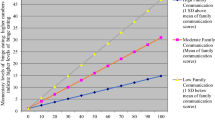Abstract
This study examines the correlation between family variables and delinquency (both self-reported and official) in a small sample of British teenage girls. Factor analysis of the 72-item Home Life Questionnaire (from T. H. Hirschi [1969] Causes of Delinquency, University of California Press, Berkeley) revealed a clear four-factor structure of caring and communication, discipline, pressure and mother-daughter closeness, which cumulatively accounted for 31% of the variance. Multiple regression of these factors onto self-reported delinquency indicated the maternal factor to be most powerful, explaining 25% of the variance in self-reported delinquency. Institutionalized and noninstitutionalized girls showed only chance differences in terms of the quality of their home life.
Similar content being viewed by others
References
Andry, R. (1960).Delinquency and Parental Pathology. Methuen, London.
Bandura, A., and Walters, R. (1963).Social Learning and Personality Development. Holt, Rinehard and Winston, New York.
Becker, W. (1964). Consequences of different kinds of parental discipline. In Hoffman, M., and Hoffman, L. (eds.),Review of Child Development Research. Vol. 1. Russel Sage, New York.
Blos, P. (1957). Preoedipal factors in the etiology of female delinquency.Psychoanal. Studies Child. 12, 229–242.
Bowlby, J. (1953).Child Care and the Growth of Love. Penguin, Harmondsworth, England.
Campbell, A. (1977).The Role of the Peer Group in Female Delinquency. Doctoral thesis, Oxford University.
Canter, R. (1982). Family correlates of male and female delinquency.Criminol. 20: 149–167.
Child, D. (1970).The Essentials of Factor Analysis. Holt, Rinehart and Winston, New York.
Conger, J. (1973).Adolescence and Youth: Psychological Development in a Changing World. Harper & Row, New York.
Cowle, J., Cowle, V., and Slater, E. (1968).Delinquency in Girls. Heineman, London.
Datesman, S., and Scarpitti, F. (1975). Female delinquency and broken homes.Criminol. 13: 35–56.
Felice, M., and Offord, D. (1972). Girl delinquency: A review.Correct. Psychiatr. 17: 18–33.
Friedlander, K. (1947).The Psychoanalytic Approach to Juvenile Delinquency. Rontledge and Kegan Paul, London.
Gibbons, D., and Griswald, M. (1957). Sex differences among juvenile court referrals.Sociol. Social Res. 42: 106–110.
Gibson, H., Morrison, S., and West, D. (1970). The confession of known offences in response to a self reported delinquency schedule.Brit. J. Criminol. 10: 277–280.
Gilbert, J. (1972). Delinquent (approved school) and nondelinquent (secondary-modern school) girls.Brit. J. Criminol. 12: 325–356.
Gold, M., and Reimer, D. (1972).Changing Patterns of Delinquent Behavior Among Americans 13 through 16 Years Old. Research Center for Group Dynamics, Ann Arbor, MI.
Gove, W., and Crutchfield, R. (1982). The family and juvenile delinquency.Sociol. Q. 23: 301–319.
Henggeler, S. (1982).Delinquency and Adolescent Pathology. John Wright, Littleton, MA.
Hirschi, T. (1969).Causes of Delinquency. University of California Press, Berkeley.
Jensen, G., and Eve, R. (1976). Sex differences in delinquency: An examination of popular sociological explanations.Criminol. 13: 427–448.
Koller, K. (1971). Parental deprivation, family background and female delinquency.Br. J. Psychiatr. 118: 317–327.
Martin, B. (1975). Parent-child relations. In Horowitz, F. (eds.),Review of Child Development Research, Vol. 4. University of Chicago Press, Chicago.
McCord, W., McCord, J., and Zola, I. (1959).Origins of Crime. Columbia University Press, New York.
Monohan, T. (1957). Family status and the delinquent child: A reappraisal and some new findings.Social Forces 35: 250–258.
Morris, R. (1964). Female delinquency and relational problems.Social Forces 43: 82–89.
Norland, S., Shover, N., Thornton, N., and James, J. (1979). Intrafamily conflict and delinquency.Pac. Sociol. Rev. 22: 223–240.
Nye, F. (1958).Family Relationship and Delinquent Behavior. Wiley, New York.
Offord, D., Abrams, N., Allen, N., and Ponshinsky, M. (1979). Broken homes, parental psychiatric illness and female delinquency.Am. J. Orthopsychiat. 49: 252–264.
Patterson, G. (1982).Coercive Family Process. Castalia Publishing Company, Eugene, OR.
Reckless, W. (1961). A new theory of delinquency and crime.Fed. Probation 25: 42–46.
Richardson, H. (1969).Adolescent Girls in Approved Schools. Routledge and Kegan Paul, London.
Riege, M. (1972). Parental affection and juvenile delinquency in girls.Br. J. Criminol. 12: 55–73.
Rosen, L. (1970). The broken home and male delinquency. In Wolfgang, M., Savitz, M. L., and Johnson, N. (eds),The Sociology of Crime and Delinquency. Wiley, New York.
Rutter, M. (1971). Parent-child separation: Psychological effects on the children.J. Child Psychol. Psychiat. 12: 233–260.
Stewart, C., and Zaenglein-Senger, M. (1984). Female delinquency family problems and parental interactions.Soc. Casework: J. Contemp. Soc. Work 65: 428–432.
Toby, J. (1957). The differential impact of family organization.Am. Sociol. Rev. 22: 505–512.
Walker, A. (1972). Special problems of delinquent and maladjusted girls. In Mays, J. (ed.),Juvenile Delinquency, The Family and The Social Group. Longman, London.
Wattenberg, N., and Saunders, F. (1954). Sex differences among juvenile offenders.Sociol. Soc. Res. 39: 24–31.
Weeks, H. (1940). Male and female broken home rates by type of delinquency.Am. Sociol. Rev. 5: 601–609.
West, D., and Farrington, D. (1973).Who Becomes Delinquent? Heinemann, London.
Widsmeth, J. (1972). Reported dependent behaviors toward mother's use of alcohol in delinquent girls.diss. Abstr. Int. 33(4-B): 1810.
Widesmeth, J., and Mayer, J. (1971). Drinking behaviors and attitudes toward alcohol in delinquent girls.Int. J. Addict. 6: 453–461.
Wilkenson, K. (1974). The broken family and juvenile delinquency: Scientific explanation or ideology?Soc. Probl. 21: 726–739.
Author information
Authors and Affiliations
Additional information
Anne Campbell's research interests are in sex differences in antisocial behavior, especially aggression.
Rights and permissions
About this article
Cite this article
Campbell, A. Self-reported delinquency and home life: Evidence from a sample of British girls. J Youth Adolescence 16, 167–177 (1987). https://doi.org/10.1007/BF02138918
Received:
Accepted:
Issue Date:
DOI: https://doi.org/10.1007/BF02138918



